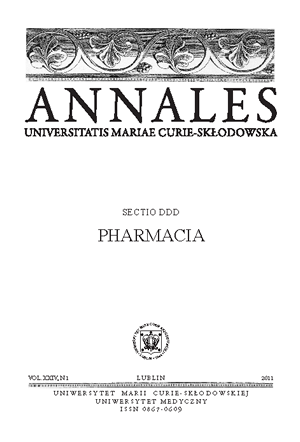Determination of phenolic acids in raw garlic (Allium sativum L.)and onion (Allium cepa L.) bulbs
Keywords:
Allium sativm L., Allium cepa L., phenolic acids, 2D-TLC and RP-HPLC analysisAbstract
The analysis of free and liberated (by acidic and alkaline hydrolysis) phenolic acids in raw garlic (Allium sativm L.) and onion (Allium cepa L.) bulbs was performed by 2D-TLC and RP-HPLC methods. 13 phenolic acids were identified: ellagic, chlorogenic, homoprotocatechuic, potocatechuic, caffeic, gentisic, p-hydroxyphenylacetic, p-hydroxybenzoic, p-coumaric, vanillic, syringic, sinapic and ferulic. Using the RP-HPLC, the content of 7 major phenolic acids was determined, which ranged from 0.05 to 85.8 µg/g of the fresh material (0.1-252.1 µg/g of dried material) in garlic (Allium sativm L.) and from 0.05 to 5.8 µg/g of the fresh material (22.4-76.3 µg/g of dried material) in onion (Allium cepa L.).
References
1. Bianchini F., Vainio H.: Allium vegetables and organosulphur compounds: do they help prevent cancer. Environ. Health Perspect., 109 (9), 893, 2001,
2. Brahma N. Singh et al.: Polyphenolics from various extracts/fractions of red onion (Allium cepa) peel with potent antioxidant and antimutagenic activities. Food Chem. Toxicol., 47 (6), 1161, 2009.
3. Chandra H. et al.: Antibacterial activity of Allium sativum (L.) against bacteria isolated from upper respiratory tract. IUP J. Life Sci., 4 (4), 43, 2010.
4. Galeone C. et al.: Allium vegetable intake and risk of acute myocardial infraction in Italy. Eur. J. Nutr., 48, 120, 2009.
5. Hsing A.W. et al.: Allium vegetables and risk of prostate cancer: a population-based study. J. Nation. Canc. Inst., 94 (21), 1648, 2002.
6. Kassim M. et al.: Ellagic acid, phenolic acids, and flavonoids in Malaysian honey extracts demonstrate in vitro anti-inflammatory activity. Nutr. Res., 30 (9), 650, 2010.
7. Keusgen M. et al.: Wild Allium species (Alliaceae) used in folk medicine of Tajikistan and Uzbekistan. J. Ethnobiol. Ethnomed., 2 (18), 1, 2006.
8. Ly T. et al.: Antioxidative compounds from the outer scales of onion. J. Agric. Food Chem., 53 (21), 8183, 2005.
9. Mantawy M., Mahmoud A.: Effect of Allium cepa and Allium sativum feeding on glucose, glycogen, protein bands profile and phenol oxidase activity in Biomphalaria alexandrina. J. Egypt. Soc. Parasit., 32 (1), 271, 2002.
10. Neureddine B., Shiomi N.: Fructooligosaccharides of edible Alliums: occurrence, chemistry and health benefits. Curr. Nutr. Food Sci., 2, 181, 2006.
11. Nishimura H., Higuchi O., Tateshita K.: Antioxidative activity of sulphur-containing compounds in Allium species for human LDL oxidation in vitro. BioFactors, 21, 277, 2004.
12. Nowak R., Zgórka G.: Phenolic acids in fruits and leaves of Ribes nigrum L. and Ribes grossularia L. Acta Polon. Pharm.-Drug Res., 54 (2), 155, 1997.
13. Nowak R., Cybul M., Starek K.: Chromatographic evaluation of phenolic acids in some cultivated Aloë species. Ann. UMCS Sect. DDD., 22 (4), 113, 2009.
14. Pharmacopoea Polonica. Ed. 7. Vol. 1., Warszawa: Polskie Towarzystwo Farmaceutyczne, 2007.
15. Prakash D., Singh B.N., Upadhyay G.: Antioxidant and free radical scavenging activities of phenols from onion (Allium cepa). Food Chem., 102 (4), 1389, 2007.
16. Rogerio A, Sá-Nunes A, Faccioli L.: The activity of medicinal plants and secondary metabolites on eosinophilic inflammation. Pharmacol. Res., 62 (4), 298, 2010.
17. Schmidtlein H., Herrmann K.: On the phenolic acids of vegetables. IV. Hydroxycinnamic acids and hydroxybenzoic acids of vegetables and potatoes (author's transl). Z. Lebensm. Unters. Forsch., 159 (5), 255, 1975.
18. Shamim S., Waseemuddin Ahmed S., Azhar I.: Antifungal activity of Allium, Aloë, and Solanum species. Pharm. Biol., 42 (7), 491, 2004.
19. Singh T.U. Kuma D., Tandan S.K.: Paralytic effect of alcoholic extract of Allium sativum and Piper longum on liver amphistome, Gigantocotyle explanatum. Indian J. Pharmacol., 40 (2), 64, 2008.
20. Singh U.P. et al.: Investigation on the phenolics of some spices having pharmacotherapeutic properties. J. Herb. Pharmacother., 4 (4), 27, 2004.
21. Smolarz H.D., Waksmundzka-Hajnos M.: Two-Dimensional TLC of phenolic acids on cellulose. J. Planar Chromatogr., 44, 278, 1993.
Downloads
Published
Issue
Section
License
Copyright (c) 2011 Authors

This work is licensed under a Creative Commons Attribution-NonCommercial-NoDerivatives 3.0 Unported License.


